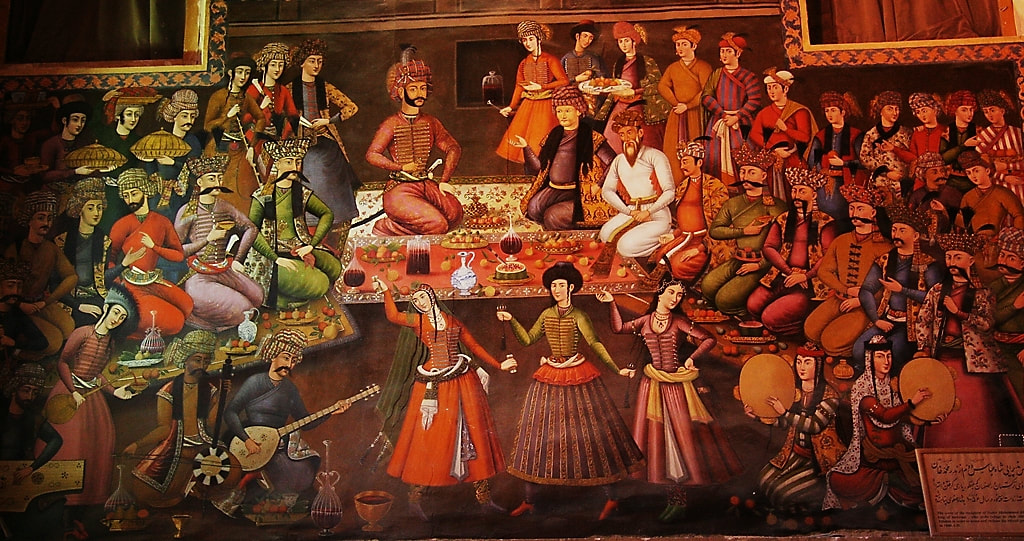|
[Attar (1145 – 1221 AD) was a Sufi, poet and theoretician of mysticism, who had a lasting influence on Iranian poetry and Sufism. Reliable information on Attar’s life is scarce but most sources agree that he was from Nishapur, a major city of medieval Khorasan, located now in northeast Iran and that he died a violent death in the massacre which Mongols inflicted on Nishapur in 1221 AD. [1] Attar started his career as a pharmacist and his patients used to confide their troubles with him, which affected him deeply. Finally, he abandoned his pharmacy practice and traveled throughout the Middle East, getting initiated into Sufism.
With the attack of the Mongols, the invading armies burned many books, including Attar’s. However, his major masterpiece, “The Conference of the Birds,” survived, within which he shares his famous Seven Valleys of Love or the mystic path to enlightenment. His seven valleys are: The valleys of Quest, Love, Understanding, Detachment, Unity, Bewilderment, and Death. As we journey into our own souls toward self-knowledge, he said, we also journey through the heavens because at the center of our soul lies the divine itself. Attar’s works reflect the evolution in Sufi mystic thought—the idea that the body-bound soul awaits release and return to its source in the other world, which can be experienced during the present life in mystic union attainable through inward purification. The great Sufi poet, Rumi, once said about Attar that, “Attar has traversed the seven cities of Love; We are still at the turn of one street.” [2] “The Conference of the Birds” is the story of the quest for enlightenment. It is portrayed through a beautiful tale of a flock of birds and their leader, a hoopoe, the wisest of them all, who search for the legendary bird, the Simorgh. The hoopoe leads the birds, each of whom represent a human fault which prevents human kind from attaining enlightenment. After passing through the seven valleys, only 30 birds remain. [3] In the last valley they reach a mirror within which they see their own reflection. At that point the birds learn that they themselves are the Simorgh; the name Simorgh in Farsi means thirty (si) birds (morgh). And so they come to "understand that the majesty of the Beloved is like the sun that is reflected in a mirror and whoever looks into that mirror will also behold her own image." [4] ------------------------------------------------------------------------------ Sources: [1] Attar Farid-al-Din. Encyclopedia Iranica. http://www.iranicaonline.org/articles/attar-farid-al-din-poet [2] "Attar of Nishapur." From Wikipedia, the free encyclopedia. CC BY SA. [3] "The Conference of the Birds." From Wikipedia, the free encyclopedia. CC BY SA. https://en.wikipedia.org/wiki/The_Conference_of_the_Birds [4] Quoted from The Conference of the Birds by Attar, p 17-18, edited and translated by Sholeh Wolpe, W. W. Norton & Co 2017. Do you know that the practice of meditation, widely used in the Islamic mystic (Sufi) tradition, increases grey matter concentration in the brain? A group of Harvard neuroscientists led by Sara Lazar, PhD, showed that after eight weeks of meditation, the grey matter concentration increases in areas of the brain which improves learning and memory, regulating emotions, sense of self and having perspective.
----------------------------------- Reference: Sara Lazar Website, https://scholar.harvard.edu/sara_lazar/home Photo: www.pixabay.com With the recent horrific persecution of the Gonabadi Sufi Order in Iran, we must ponder how the Sufi became a target of the extremist Islamic regime in Iran. Contrary to what some say, Sufism is not a sect, but it exists in both Sunni and Shia Islam as a method and approach toward the religion. Sufis, like yogis, are mystics who focus on the purification of their inner self. Many of Islam’s greatest poets and scholars during the Islamic Golden Age such as Rumi, Suhrewardi, Shabistari, Hafez and Saadi were Sufi. In the beginning of the 16th century, when most of Iran fell under the control of the Safavid dynasty, many active Sufi Orders existed throughout the region. The Safavid monarch himself was a Sufi and his dynasty owed its origin to the Sufi Order founded by the mystic Safi-ad-din Ardabili (1253-1334 AD). However, for several reasons including the need to centralize power, the monarchs felt the need to move away from Sufism and establish Twelver Shiism as the state-sponsored religion of the Kingdom. A class of Shia clerics emerged and so did a brutal systematic suppression of Sufism. It is the irony of history that the demise of Sufism came under the Safavids, who themselves came to power as a Sufi network. [1] Since the 1979 revolution, the Iranian government which fears a popular interest in Sufism has intensified its persecution of Sufi Orders. The Sufi lack of interest in exoteric Islam and religious laws have always been a point of conflict between the Sufi and the clerics. The Gonabadi Order is one of the three main branches of Nematollahi Sufi Order which traces its origin to 14th century Iran. Their core ethical beliefs can be summarized as selflessness, generosity, broadness of spiritual vision and religious tolerance. They are devoted to the use of music in their ceremonies and the beautiful writings of Sufi poets such as Rumi. [2] The Iranian clergy who do not agree with the Sufi belief system continue to demolish their centers and find excuses to imprison their leaders. The level of hatred and persecution of Sufi mystics has become so absurd, that Tehran’s Police Chief and Revolutionary Guard Corp General Rahimi went so far as saying that it’s a merciful act on the part of the Iranian regime to not be using RPGs against the Gonabadi dervishes. [3] ------------------------------------------------------------------------------------------------ Sources include: [1] Anzali, Ata. “Mysticism in Iran: The Safavid Roots of a Modern Concept” [2] UNHCR, The UN Refugee Agency. “Iran: Information about the Gonabadi dervishes…”; [3] Radio Farda. "We Could Have Used An RGP Against Dervishes," says Police Chief. Feb 23, 2018. |
Details
AuthorSaghi (Sasha) Archives
May 2019
Categories |



 RSS Feed
RSS Feed